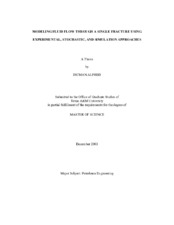| dc.description.abstract | This research presents an approach to accurately simulate flow experiments through a fractured core using experimental, stochastic, and simulation techniques. Very often, a fracture is assumed as a set of smooth parallel plates separated by a constant width. However, the flow characteristics of an actual fracture surface are quite different, affected by tortuosity and the impact of surface roughness. Though several researchers have discussed the effect of friction on flow reduction, their efforts lack corroboration from experimental data and have not converged to form a unified methodology for studying flow on a rough fracture surface.
In this study, an integrated methodology involving experimental, stochastic, and numerical simulations that incorporate the fracture roughness and the friction factor is shown to describe flow through single fractures more efficiently. Laboratory experiments were performed to support the study in quantifying the flow contributions from the matrix and the fracture. The results were used to modify the cubic law through reservoir simulations. Observations suggest that the fracture apertures need to be distributed to accurately model the experimental results.
The methodology successfully modeled fractured core experiments, which were earlier not possible using the parallel plate approach. A gravity drainage experiment using an X-ray CT scan of a fractured core has also validated the methodology. | en |


